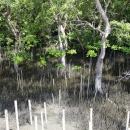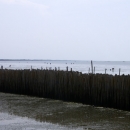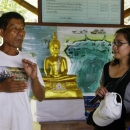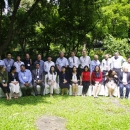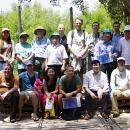Grants :: Regional Grant Facilities :: Income for coastal communities for mangrove protection
Income for coastal communities for mangrove protection
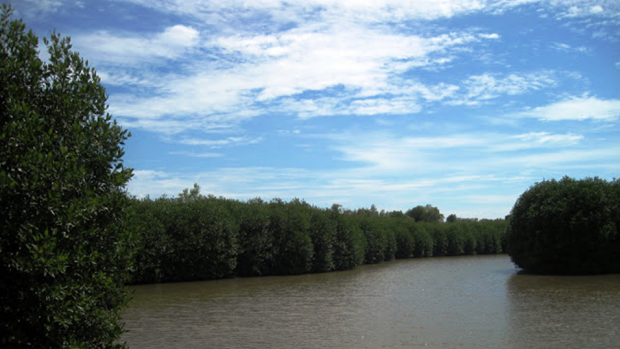
Integrated mangrove-shrimp farming plays a key role in susta ... , Ca Mau, Viet Nam © IUCN, 2013
Objectives
The project goal is to conserve and restore mangroves by introducing sustainable financing for coastal communities.
The project aims to develop a low cost mechanism enabling investors to responsibly promote mangrove conservation, carbon emissions reduction and sustainable development, through the provision of funding to local communities for livelihood diversification, resource enhancement and coastal protection.
Background
The project seeks to develop a mechanism enabling investors to responsibly promote mangrove conservation/restoration, carbon emissions reduction and sustainable development through the provision of funding to local communities. A key purpose of the mechanism is to facilitate flows of funding to smaller mangrove areas in support of environmental externalities where entry into voluntary and compliance markets for carbon is not economically feasible. The mechanism will also provide an alternative income for fisher folk enabling reduction of fishing effort and regeneration of fish stocks.
Conservation and restoration of mangroves will also support sustainable fisheries management and support rebuilding of fish stocks. The work thus aims to facilitate mangrove conservation/restoration, replenishment of fish stocks and livelihood development while providing public and corporate entities with an opportunity to invest in climate change mitigation and socio-economic development.
Target beneficiaries
The project mainly targets coastal fishing communities in the identified countries.
Outputs
The project has resulted in the design of a new low-cost mechanism that enables investors to promote mangrove conservation and restoration through provision of funding to local communities. The new mechanism provides a simple yet credible methodology to ensure mangrove areas are monitored and protected, carbon stocks are assessed, and local communities are involved in and benefit from project activities.
The new mechanism is presented as a series of four MFF-FAO publications, designed to be used collectively to guide the establishment of a sustainable financing for mangrove protection. These reports are outlined below.
| |
‘Financing for mangrove protection with emphasis on Pakistan, Thailand and Viet Nam’ • Identifies and describes 54 sources of financing for mangrove protection and restoration activities in Pakistan, Thailand, and Viet Nam. • Covers four financing categories – multilateral public finance, bilateral public finance, domestic public finance and private-sector initiatives. • Identifies strengths and weaknesses of each category. • Provides summary information on relevant projects for each source.
|
| |
‘Mangrove-related policy and institutional frameworks in Pakistan, Thailand and Viet Nam’ • Assesses the suitability of policy and institutional frameworks in Pakistan, Thailand, and Viet Nam for projects providing performance-based incentives to local communities for mangrove protection. • Contains recommendations for establishing local level mangrove protection initiatives in Pakistan, Thailand, and Viet Nam, including information on potential parties and their respective roles and responsibilities. |
| |
‘Mangrove carbon estimator and monitoring guide’ • A low-cost methodology for estimating carbon stocks and monitoring mangroves. • Three components: project area mapping, mangrove monitoring and carbon estimation. • Mapping and monitoring are implemented using smartphone GPS apps, the Global Forest Watch platform and free QGIS software. • Tasks are designed to be undertaken by local communities after initial training. |
| |
‘Incentive allocation for mangrove protection’ • A simple methodology for investors to provide performance-based incentives for mangrove protection activities undertaken by local communities. • Identifies and outlines responsibilities of five involved parties – the financier, the local community, the government, the technical assistance body and a third-party auditor. • Contains step-by-step instructions on establishing project financing arrangements. • Contains a template agreement for use by local communities and financiers
|
Accomplishments and challenges
Under the new mechanism, mangrove mapping and monitoring are implemented using low-cost tools such as GPS units, smartphones, and free software and online platforms. Carbon stocks are estimated using two simple parameters – plot latitude and standing mean basal area – thus reducing field time and equipment costs. The majority of the tasks can be undertaken by local communities after initial training by mangrove experts, reducing costs and improving project ownership and sustainability. The mechanism clearly identifies involved parties and provides step-by-step instructions on project development, implementation and financing.
By reducing the costs of mangrove monitoring and carbon estimation, the mechanism allows protection and restoration of smaller areas of mangroves that are currently priced out of international carbon initiatives. It is designed to be used by private- and public-sector investors throughout Asia. By providing a simple, standardised yet flexible methodology, it has the potential to significantly increase investment in mangrove protection and restoration.
The mechanism was designed by MFF and FAO over a period of two years, with contributions from international mangrove experts, government agencies and academia. It was informed by visits to mangrove sites in Pakistan, Thailand and Vietnam, which included field-testing and extensive consultations with mangrove communities and local governments. The methodology for measuring mangrove carbon stocks was designed in collaboration with Yale University and was published in PLOS ONE journal in January 2017 (http://journals.plos.org/plosone/article?id=10.1371/journal.pone.0169096).
Information on project outputs was shared with mangrove experts and stakeholders in Pakistan, Thailand and Viet Nam at the final project workshop, held in Bangkok on 20-21 December 2016. The workshop successfully demonstrated the low-cost mangrove mapping, monitoring and carbon estimation mechanism, and the incentive allocation mechanism developed by the project.
Workshop discussions have also identified a number of opportunities for piloting these mechanisms. These opportunities will be investigated by FAO and MFF in the coming months, potentially resulting in demonstration projects in 2017.
Contributions to cross-cutting themes
Climate change: The project has developed a low-cost mechanism that will enable investors to promote mangrove conservation and restoration. Mangroves contain large amounts of carbon (both within vegetation and soils), and act as carbon sinks. Mangrove conservation and restoration thus directly contributes to climate change mitigation. In addition, mangroves provide increased protection against storms and floods, thus improving climate change resilience of local communities.
Property rights and resource tenure: In all three project countries, mangrove resource tenure is a hotly debated topic. Different government bodies are responsible for land, forest and coastal area management, leading to a lack of coordination and conflicting regulation. While all forests are generally state-owned, nearby communities often exercise de facto land use rights, including fishing, fuelwood collection and harvesting of NTFPs. The lack of tenure clarity often leads to disputes and unsustainable management of resources. For each country, mangrove and land tenure were clarified via a comprehensive policy review and field visits.
Country
Location
Coastal communities in Pakistan, Thailand, and Viet Nam
Topic
Duration
1st Dec 2014 to 31st Dec 2016
MFF Grant Amount
USD 188,076
Implementing Partner
- Food and Agricultural Organisation of the United Nations - http://www.fao.org/home/en/
- Spatial Informatics Group - Natural Assets Laboratory (SIG-NAL) - http://sig-nal.org/
- International Centre for Environmental Management (ICEM) - www.icem.com.au
- USAID-funded Lowering Emissions in Asia’s Forest (LEAF) program - http://www.leafasia.org/
- Mangrove Action Project (MAP) - http://mangroveactionproject.org/
- UN-REDD - http://www.un-redd.org/
